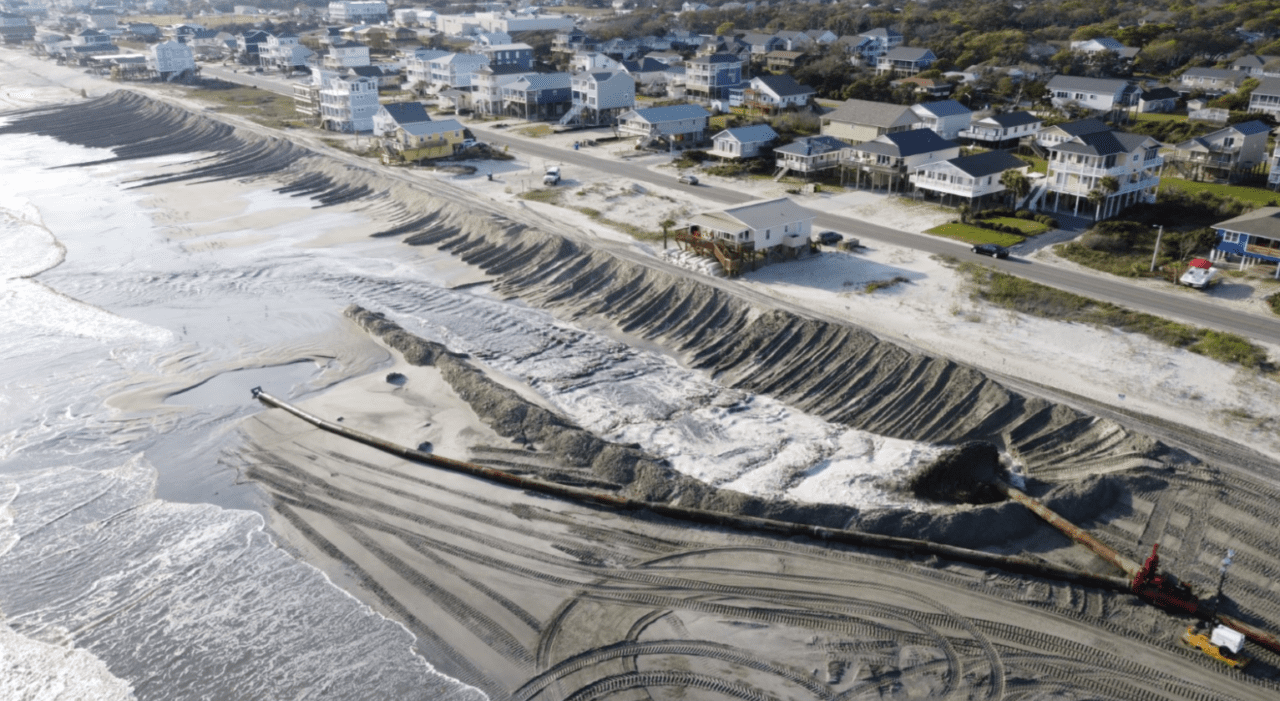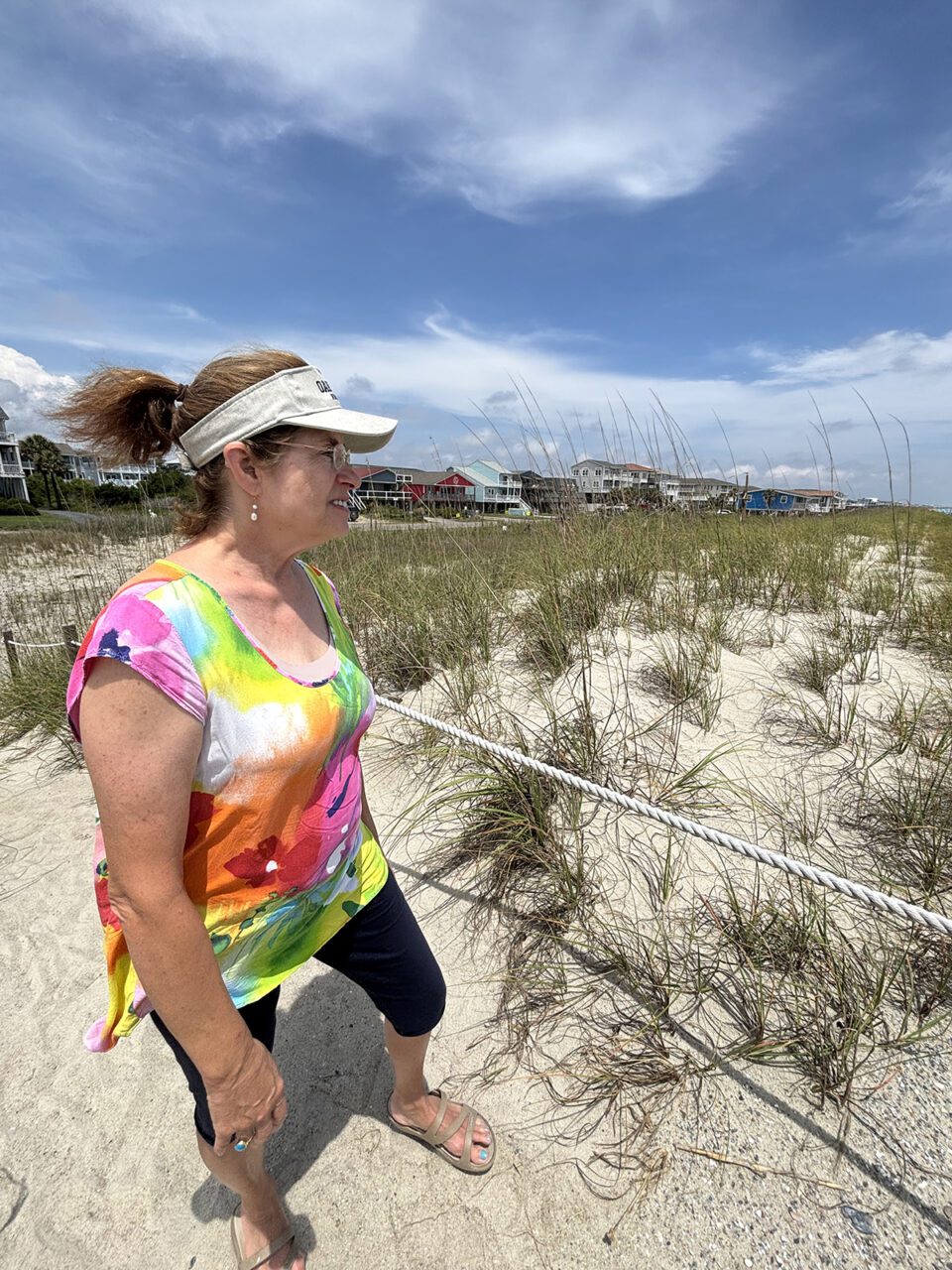
OAK ISLAND – When Gigi Donovan looks at the dune fronting a row of largely undeveloped oceanfront lots across the street from her home, she sees a false sense of security.
“We’ve seen this dune go away three times in 12 years,” she said.
Supporter Spotlight
The sandy mound that separates the public beach from private lots along a stretch of East Beach Drive wasn’t here just a few years ago. It has been built up and planted with dune-stabilizing sea oats through the town of Oak Island’s efforts to restore its oceanfront shore.
Now there is enough of it to render at least one of the thin slices of long-vacant beachfront lots suitable for building.
That has Donovan and several of her neighbors worried.
Amber and Dean Russell live a few doors down from the Donovans. When the Russells bought their bungalow in 2022, they went ahead and purchased the beachfront lot directly across the street.
“We bought that just to keep our view,” Amber Russell said. “It’s not safe to build on.”
Supporter Spotlight
That’s a sentiment a group of homeowners and residents who live in the area of SE 58th Street and East Beach Drive have expressed to town officials in the days and months since they received notice that a developer had applied for a Coastal Area Management Act, or CAMA, permit to build a house on one of the oceanfront lots.
They’ve made countless telephone calls and sent emails to North Carolina Division of Coastal Management and U.S. Army Corps of Engineers staff.
They’ve posted handmade signs that read “SAVE OUR BEACHFRONT — No Building on Narrow, At-risk Lots!” along their block of East Beach Drive.
They started an online petition that, as of June 13, had more than 600 signatures.
They’ve dug in their heels and pushed back, calling “for the return to responsible, sustainable environmental development on fragile oceanfront properties” in a plea to Oak Island’s mayor.
But even they acknowledge this fight is an uphill battle, one that is likely to rage on as low-lying coastal areas deal with the effects of sea level rise, more frequent, intense coastal storms and shoreline erosion.
Regulatory flexibility
Last month, a CAMA minor permit was issued for 5515 East Beach Drive. Proposed building plans on the 0.17-acre lot include a 2,856 square-foot house.
Town officials in an email responding to questions said they do not have on file when a home last stood on that lot. Aerial satellite images from Brunswick County show that this particular block of East Beach Drive had more homes along the oceanfront in 1989 than today.
The homes captured by satellite imagery in 1989 were gone in 2003, destroyed by nature or demolition.
Today, houses stand on only two of the oceanfront lots along this block of East Beach Drive.
Oak Island officials said the town does not have an overarching designation determining whether a lot is buildable based on oceanfront construction setbacks.
“For building on an oceanfront lot, the developer would submit information to show compliance with CAMA regulations and receive a permit if they meet said requirements,” an official said in an email.
Back in 2023, the North Carolina Coastal Resources Commission rubber-stamped Oak Island’s beach management plan, which gives beachfront builders more regulatory flexibility regarding how far back they must build from the sea.
The year before, the commission repealed regulations that allowed coastal communities to use the less restrictive setback measurement line for oceanfront construction, instead requiring builders to measure back from what is referred to as the preproject vegetation line.
The preproject vegetation line is the first line of stable, natural vegetation that is on an oceanfront before a large-scale beach nourishment project begins, one where more than 300,000 cubic yards of sand is placed on the beach.
But coastal communities that create and follow beach management plans approved by the commission may measure setbacks from the vegetation line rather than the preproject line as long as they meet the obligations detailed in their plans. Setbacks are 60 feet from the measurement line.
Coastal Resources Commission approved beach management plans for five coastal towns: Carolina Beach, Kure Beach and Wrightsville Beach in New Hanover County, and Oak Island and Ocean Isle Beach in Brunswick County. Once approved, plans must be reauthorized every five years.
Oak Island’s authorized plan calls for placing a total estimated 16.2 million cubic yards of sand on the beach over the next three decades. Under the plan, the beach will be nourished every six years.
Oak Island’s most recent sand nourishment projects were carried out in 2021 and 2022.
A nourishment project originally planned for winter 2024-25 was postponed after the town was informed contractor bids for the project “had far exceeded the amounts expected or budgeted,” according to the town’s website.
The project is again out for bids, and town officials anticipate a contract will be awarded and work will begin later this year.
Risky building
“They’re looking to the renourishment as the permanent solution,” Donovan said.
Dr. Gavin Smith, a North Carolina State University professor who researches hazard mitigation, disaster recovery and climate change adaptation, is not a big fan of beach nourishment.
“I think that overrelying on beach nourishment as a way to protect coastal development is fraught with problems,” he said in a telephone interview earlier this month. “It’s extremely expensive. It can take several seasons or it can take one bad storm and it’s gone.”
Smith pointed out that coastal zones, in particular barrier island, are highly dynamic and subject to significant change.
“Thinking about the construction of a house in a highly dynamic area, I think we need to be really careful,” he said. “Builders and homebuyers need to think about the life of that structure. The conditions that that site might face in 40 or 50 years is worthy of consideration. Individuals need to think about and actually ask a question: While you might be able to legally build in a given place, should you build there? I think that’s something that we all need to perhaps be more aware of.”
It’s time governments at all levels, local, state and federal, “do better,” he said.
“How can we recognize or applaud local governments that have the political will to adopt more stringent standards than the minimums? That’s what many governments adhere to is the minimum standards” Smith said. “Our codes are inadequate in the state, yet that’s what we adhere to in many cases. The National Flood Insurance Program should be viewed as a minimum, not the maximum. In an era of climate change we’re moving toward this idea of nonstationary, which we don’t know what the future holds. So, therefore our codes and standards ought to be that much more rigorous to account for the uncertainty. But instead, we’re relying on old data. We’re relying on old codes and that’s a significant problem.”

Sitting at the kitchen table in her home on a late May afternoon, Donovan mulled the many concerns she, her husband Mark, and their neighbors have raised to government officials.
They worry about whether more lights from new construction will hinder sea turtles from nesting on the shore. They worry about how stormwater runoff from new rooftops, driveways and other impervious surfaces may exacerbate flooding on their second-row lots.
They worry what one unwelcome coastal storm, be it a hurricane of any category or a potential tropical cyclone that packs a punch like the unnamed storm that pummeled Brunswick County last year, might do to the dune and any homes standing on the small land plots just behind it.
“We don’t know. That’s the thing. We don’t know what’s going to happen,” Gigi Donovan said.
In a statement to the town’s mayor last month, the Donovans and their neighbors wrote: “While we cannot control the weather, we can mitigate the damage it causes by responsibly managing the development of oceanfront properties.”
Oceanfront lot development “should be based on comprehensive land-use plans that take into consideration beach erosion, turtle nesting habitat, climate change, protection of private and town property, and preserving the legacy of (Oak Island) as a quaint, family-focused beach community.”
They are appealing to Coastal Resources Commission Chair Renee Cahoon, who determines whether or not property owners can make their case in a hearing before the full commission.
“We are very motivated and stubborn,” Gigi Donovan said in a text message. “If we allow them to plow ahead, steam-rolling any local opposition, our entire island beachfront will be irreparably destroyed.”







